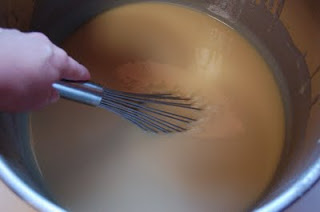I start with weighing and melting my oils.

My lye is weighed and ready.

Next I take my bag of frozen goat milk out of the freezer, chop it up into smaller chunks, and put it in a stainless steel bowl. The chemical reaction of adding lye to milk causes the milk to heat up considerably. Freezing the goat milk keeps this reaction cooler thus keeping the sugar in the milk from burning and turning a brownish yellow when combined with the lye.

Adding the lye ( a little at a time) to the frozen milk. Adding too fast and you can get burnt milk.

The lye's chemical reaction starts to melt the milk.

All the lye has been added and dissolved and the milk is almost completely melted and ready to be added to the oils. The milk has stayed nice and white in color.

Here I am adding the the milk/lye mixture to the melted oils. I always use a strainer when doing so. This prevents any undissolved bits of lye from getting into the mixture and creating unwanted "lye pockets" in the finished soap.

Now that the milk/lye solution has been added to the melted oils, I use a stick blender to mix the raw soap.

Here's my clove bud fragrance oil measured and waiting to be added.

The fragrance oil has now been added and I'm continuing to hand blend the soap till it reaches the right consistency for pouring.

The soap has now been poured in molds aka pvc pipes. I've placed a thermometer in the soap to keep an eye on the temperature. Allowing the soap to get too warm will burn the milk that's in the soap. You really have to watch temperature when working with milk soaps.

Keeping detailed notes is essential in soap making, especially when trying new recipes and fragrances.

Here I'm checking the temperature of the soap. The saponification process generate heats and if the soap gets too hot, too fast, not only will it burn the milk, it can actually do what soapmaker's call "volcano", which means the soap gets hot enough to expand up and out of your soap mold. It's very reminiscent of lava pouring out of a volcano, thus the name.

It's the next morning and I've unmolded the soap.

The soap got a little too warm causing it to expand and crack in the mold. This is more of a cosmetic problem but I made a note of this in my records and next time I'll try and keep temps a little lower when I make this soap.

Here's the soap being cut on our home made soap cutter.

Here's the soap cut and ready to be put out on our curing racks. This soap had no colorants added, but the fragrance oil did cause it to discolor to a lovely tan. It fits the fragrance so I don't mind. After 6 weeks cure time this soap will be ready to use!
